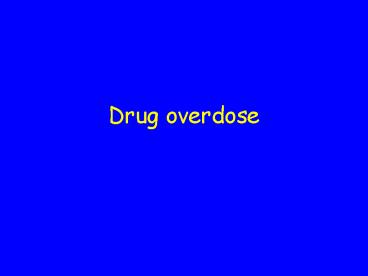Drug overdose - PowerPoint PPT Presentation
1 / 28
Title:
Drug overdose
Description:
... (with/without heart block) ... at relatively low concentration Hypoglycaemia Prolongation of QT and ventricular arrhythmias Stellate ganglion bock: ... – PowerPoint PPT presentation
Number of Views:682
Avg rating:3.0/5.0
Title: Drug overdose
1
Drug overdose
2
Some basic principles
- Resuscitation
- Decontamination drug may be in the stomach, or
(in industrial accidents) on the skin/clothing. - Seek advice from Poisons Centre.
- Supportive therapy
- Reduce further absorption from gut activated
charcoal. - Consider need for (and ability to) ? clearance
- Observe progress.
- Seek ? input.
3
Therapeutic index
Effect
Log concentration.
4
Effect
Log concentration.
5
Effect
Log concentration.
6
Effect
Log concentration.
7
Effect
Mild toxicity
Log concentration.
8
Effect
Increasingly severe toxicity
Mild toxicity
Log concentration.
9
Death
Effect
Increasingly severe toxicity
Mild toxicity
Log concentration.
10
Paracetamol
- Usually metabolised by conjugation
- This process can be saturated
- In which case CYP450
- Generation of a quinonimine
- This binds covalently to sulphydryl groups
- Thus denaturing proteins
11
Paracetamol clinical
- Ingestion of gt 15 g often fatal
- High-risk groups includes alcoholics, HIV,
severe malnutrition and those on enzyme-inducers - Multiple large doses (each sub-toxic) can cause
toxicity - Patient is often well for the first 24 hours
after ingestion - Clinical features develop late and are insidious
- Liver failure and tubular necrosis
12
Paracetamol clinical
- Risk of toxicity is predictable from drug levels
gt 4 h after overdose - N-Acetyl-cysteine generates glutathione, which
donates SH bonds. - N-AC has maximal effect within the first 14 h
(but is often used for much longer). - N-AC requires liver metabolism.
- N-AC has a large therapeutic index.
- But can cause anaphylaxis (rarely)
13
Practical tips
- Dont draw blood before 4-h.
- If time of OD in doubt, dont rely on one
estimate establish trend. - Refer to the BNF graph dont guess.
- Make detailed casenote entries.
- Be careful over units (mg/L, mmol/L).
- Check the drug chart was the n-AC dose right?
Was it given? Was it halted prematurely?
14
Monitoring.
- Symptoms hepatic pain.
- Signs low-grade fever (icterus etc.).
- INR (interaction with factor VII).
- Transaminases.
- Recognise the limits of you competence
Hepatology consultation for patients with late
presentation and/or evidence of liver damage.
15
Aspirin
- A relatively strong acid
- Can stimulate respiratory centre, causing
respiratory alkalosis - But more usually results in metabolic acidosis
- Binding to plasma proteins is non-linear
- Eliminated (in a toxic form) by GF and tubular
secretion
16
Henderson-Hasselbach
Log (protonated/unprotonated) pKa - pH
3.5 - 2.5 1 antilog(1) 10 3.5 - 6.5
-3 antilog (-3) 0.001
17
Alkaline diuresis
- Its the alkali that matters, not the rate of
diuresis - Young people cope well but urinary catheter and
accurate fluid balance chart are essential.
Check the urinary pH if possible. - In those with suspected cardiac dysfunction (and
those who are very ill) CVP monitoring.
- Aspirin has a small VD
- It can be removed by haemoperfusion
18
Tricyclics
- CNS coma, seizures
- Respiratory hypoventilation, apnoea
- Cardiovascular conduction defects, arrhythmias,
shock - Metabolic acidosis, hyperpyrexia, hypokalaemia
- Features can come on within 6 h.
- Drug-related problems are usually complete
within 48 hours
19
Tricyclics
- Cardiac problems use of antiarrhythmic drugs
should be minimised unless there is shock - Class-I agents and beta-blockers can worsen
problems - Correction of acidosis and electrolyte imbalance
- Lignocaine for VT
- Use flumazenil with caution (fits)
20
Tricyclics
- Very large volume of distribution
- So most of the drug is not in the blood
- Little chance of removing drug from the body
- No specific antidote
- Tricyclics have anticholinergic activity, and
slow gastric emptying - Decontamination is important, and charcoal may
be helpful - Observation and support
21
Digoxin
- High mortality
- Sinus bradycardia
- Supraventricular tachycardias (with/without
heart block) - Hyperkalaemia
- Decontamination charcoal
- Correct hyperkalaemia
- Dig-specific antibody fractions
- Haemoperfusion
22
Aminophylline
- Seizures, tachyarrhythmias vasodilatation
- GI upset marked vomiting
- Hypokalaemia
- Decontamination and charcoal
- Correct hypokalaemia
- Charcoal haemoperfusion increases clearance.
23
Opiates
- Quality (dose) of street drug varies.
- CNS depression
- coma
- respiratory depression ?CO2 ?O2
- Hypotension.
- Specific antidote naloxone.
- Supportive measures.
Naloxone has a short half-life and may be needed
repeatedly
24
Benzodiazepines
- Wide therapeutic index and shallow dose-response
curves. - Normal people rarely in danger.
- But respiratory problems carry risk.
- Specific antidote is flumazenil.
- Observation (gases) and support.
Again, short half-life
25
Quinine
- Quinine is more toxic in healthy people than in
malaria - Visual problems at relatively low concentration
- Hypoglycaemia
- Prolongation of QT and ventricular arrhythmias
- Stellate ganglion bock useless
- Charcoal increases clearance.
- Haemoperfusion does not increase clearance.
26
Iron
- Public perception
- Immediate GI effects - first 6 h.
- Period of clinical improvement
- Small proportion of patients deteriorate
acidosis, shock, renal failure, liver necrosis. - Late problems stricture
- Decontamination and chelator
- Parenteral chelator
27
Other heavy metals
Lead Scrap metal, lead paint, petroleum
industry Colic, encephalopathy, motor peripheral
neuropathy, renal tubular dysfunction, gum margin
pigmentation, basophilic stippling. Treatment
sodium ededate
Mercury mining. Acute poisoning (vapour)
respiratory, renal. (Mercuric chloride)
gut. Chronic poisoning (inorganic salts)
sweating, lassitude, tremor, gingivitis, organic
psychosis. Treatment BAL
28
Common household materials
Methanol metabolised to formaldehyde and causes
optic atrophy acidosis. Management ethanol,
dialysis
Carbon monoxide carboxyhaemoglobin. Management
oxygen.
Corrosives emesis or lavage are contraindicated.































